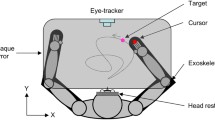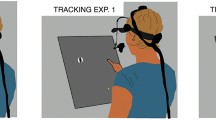Abstract
Although many studies have been devoted to motion perception during smooth pursuit eye movements, relatively little attention has been paid to the question of whether the compensation for the effects of these eye movements is the same across different stimulus directions. The few studies that have addressed this issue provide conflicting conclusions. We measured the perceived motion direction of a stimulus dot during horizontal ocular pursuit for stimulus directions spanning the entire range of 360°. The stimulus moved at either 3 or 8°/s. Constancy of the degree of compensation was assessed by fitting the classical linear model of motion perception during pursuit. According to this model, the perceived velocity is the result of adding an eye movement signal that estimates the eye velocity to the retinal signal that estimates the retinal image velocity for a given stimulus object. The perceived direction depends on the gain ratio of the two signals, which is assumed to be constant across stimulus directions. The model provided a good fit to the data, suggesting that compensation is indeed constant across stimulus direction. Moreover, the gain ratio was lower for the higher stimulus speed, explaining differences in results in the literature.









Similar content being viewed by others
Notes
In this paper we will restrict ourselves to head-centric motion, assuming that the head of the observer is stationary in space. Also, when we speak of ‘the stimulus’ or ‘stimulus velocity’, we refer to a moving object that is present in the visual field during ocular pursuit of the pursuit target, not to the pursuit target.
Strictly speaking, if we assume that both gains are sampled from normal distributions, the gain ratio would have a Cauchy distribution. Here, however, we just show a possible effect of noise in the signals, without paying too much attention to the shape of the underlying distributions.
References
Aubert H (1886) Die Bewegungsempfindung. Pflügers Arch 39:347–370
Aubert H (1887) Die Bewegungsempfindung, zweite Mitteilung. Pflügers Arch 40:459–480
Batschelet E (1981) Circular statistics in biology. Academic, London
Becklen R, Wallach H, Nitzberg D (1984) A limitation of position constancy. J Exp Psychol Hum Percept Perform 10:713–723
De Graaf B, Wertheim AH (1988) The perception of object-motion during smooth-pursuit eye movements: adjacency is not a factor contributing to the Filehne illusion. Vision Res 28:497–502
Ehrenstein WH, Mateeff S, Hohnsbein J (1986) Temporal aspects of position constancy during ocular pursuit. Pflügers Arch Eur J Physiol 406(R15):47
Filehne W (1922) Über das optische Wahrnehmen von Bewegungen. Z Sinnesphysiol 53:134–144
Freeman TCA (1999) Path perception and Filehne illusion compared: model and data. Vision Res 39:2659–2667
Freeman TCA (2001) Transducer models of head-centred motion perception. Vision Res 41:2741–2755
Freeman TCA, Banks MS (1998) Perceived head-centric speed is affected by both extra-retinal and retinal errors. Vision Res 38:941–945
Freeman TCA, Banks MS, Crowell JA (2000) Extraretinal and retinal amplitude and phase errors during Filehne illusion and path perception. Percept Psychophys 62:900–909
Goltz HC, DeSouza JFX, Menon RS, Tweed DB, Vilis T (2003) Interaction of retinal image and eye velocity in motion perception. Neuron 39:569–576
Grunewald A (2004) Motion repulsion is monocular. Vision Res 44:959–962
Mack A, Herman E (1973) Position constancy during pursuit eye movement: an investigation of the Filehne illusion. Q J Exp Psychol 25:71–84
Mack A, Herman E (1978) The loss of position constancy during pursuit eye movements. Vision Res 18:55–62
Mateeff S (1978) Saccadic eye movements and localization of visual stimuli. Percept Psychophys 24:215–224
Mateeff S, Yakimoff N, Hohnsbein J, Ehrenstein WH (1991) Perceptual constancy during ocular pursuit: a quantitative estimation procedure. Percept Psychophys 49:390–392
Matin L, Matin E, Pearce DG (1969) Visual perception of direction when voluntary saccades occur. I. Relation of visual direction of a fixation target extinguished before a saccade to a flash presented during the saccade. Percept Psychophys 5:65–80
Matin L, Matin E, Pola J (1970) Visual perception of direction when voluntary saccades occur: II. Relation of visual direction of a fixation target extinguished before a saccade to a subsequent test flash presented before the saccade. Percept Psychophys 8:9–14
McKee SP, Nakayama K (1984) The detection of motion in the peripheral visual field. Vision Res 24:25–32
Park J, Lee J, Lee C (2001) Non-veridical visual motion perception immediately after saccades. Vision Res 41:3751–3761
Rauber H-J, Treue S (1998) Reference repulsion when judging the direction of visual motion. Perception 27:393–402
Rauber H-J, Treue S (1999) Revisiting motion repulsion: evidence for a general phenomenon? Vision Res 39:3187–3196
Swanston MT, Wade NJ (1988) The perception of visual motion during movements of the eyes and of the head. Percept Psychophys 43:559–566
Turano KA, Massof RW (2001) Nonlinear contribution of eye velocity to motion perception. Vision Res 41:385–395
Tynan PD, Sekuler R (1982) Motion processing in peripheral vision: reaction time and perceived velocity. Vision Res 22:61–68
Van Donkelaar P, Miall RC, Stein JF (2000) Changes in motion perception following oculomotor smooth pursuit adaptation. Percept Psychophys 62:378–385
Van der Geest JN, Frens MA (2002) Recording eye movements with video-oculography and scleral search coils: a direct comparison of two methods. J Neurosci Methods 114:185–195
Von Fleischl E (1882) Physiologisch-optische Notizen. Sitzungsber Akad Wiss Wien 3:7–25
Von Holst E (1954) Relations between the central nervous system and the peripheral organs. Br J Anim Behav 2:89–94
Von Holst E, Mittelstaedt H (1950) Das Reafferenzprinzip (Wechselwirkungen zwischen Zentralnervensystem und Peripherie). Naturwissenschaften 37:464–476
Wallach H, Becklen R, Nitzberg D (1985) The perception of motion during colinear eye movements. Percept Psychophys 38:18–22
Wertheim AH (1987) Retinal and extraretinal information in movement perception: how to invert the Filehne illusion. Perception 16:299–308
Wertheim AH (1994) Motion perception during self-motion: the direct versus inferential controversy revisited. Behav Brain Sci 17:293–355
Acknowledgements
The authors would like to thank Dr. Herbert Hoijtink for his advice on modelling the data.
Author information
Authors and Affiliations
Corresponding author
Rights and permissions
About this article
Cite this article
Souman, J.L., Hooge, I.T.C. & Wertheim, A.H. Perceived motion direction during smooth pursuit eye movements. Exp Brain Res 164, 376–386 (2005). https://doi.org/10.1007/s00221-005-2261-6
Received:
Accepted:
Published:
Issue Date:
DOI: https://doi.org/10.1007/s00221-005-2261-6




